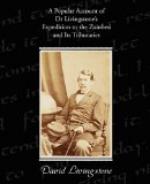Crocodiles in the Rovuma have a sorry time of it. Never before were reptiles so persecuted and snubbed. They are hunted with spears, and spring traps are set for them. If one of them enters an inviting pool after fish, he soon finds a fence thrown round it, and a spring trap set in the only path out of the enclosure. Their flesh is eaten, and relished. The banks, on which the female lays her eggs by night, are carefully searched by day, and all the eggs dug out and devoured. The fish-hawk makes havoc among the few young ones that escape their other enemies. Our men were constantly on the look-out for crocodiles’ nests. One was found containing thirty-five newly-laid eggs, and they declared that the crocodile would lay as many more the second night in another place. The eggs were a foot deep in the sand on the top of a bank ten feet high. The animal digs a hole with its foot, covers the eggs, and leaves them till the river rises over the nest in about three months afterwards, when she comes back, and assists the young ones out. We once saw opposite Tette young crocodiles in December, swimming beside an island in company with an old one. The yolk of the egg is nearly as white as the real white. In taste they resemble hen’s eggs with perhaps a smack of custard, and would be as highly relished by whites as by blacks, were it not for their unsavoury origin in men-eaters.
Hunting the Senze (Aulacodus Swindernianus), an animal the size of a large cat, but in shape more like a pig, was the chief business of men and boys as we passed the reedy banks and low islands. They set fire to a mass of reeds, and, armed with sticks, spears, bows and arrows, stand in groups guarding the outlets through which the seared Senze may run from the approaching flames. Dark dense volumes of impenetrable smoke now roll over on the lee side of the islet, and shroud the hunters. At times vast sheets of lurid flames bursting forth, roaring, crackling and exploding, leap wildly far above the tall reeds. Out rush the terrified animals, and amid the smoke are seen the excited hunters dancing about with frantic gesticulations, and hurling stick, spear, and arrow at their burned out victims. Kites hover over the smoke, ready to pounce on the mantis and locusts as they spring from the fire. Small crows and hundreds of swallows are on eager wing, darting into the smoke and out again, seizing fugitive flies. Scores of insects, in their haste to escape from the fire, jump into the river, and the active fish enjoy a rare feast.
We returned to the “Pioneer” on the 9th of October, having been away one month. The ship’s company had used distilled water, a condenser having been sent out from England; and there had not been a single case of sickness on board since we left, though there were so many cases of fever the few days she lay in the same spot last year. Our boat party drank the water of the river, and the three white sailors, who had never been in an African river before, had some slight attacks of fever.




